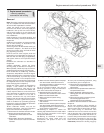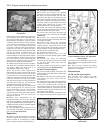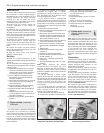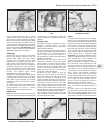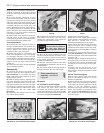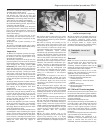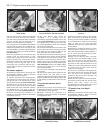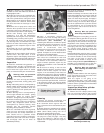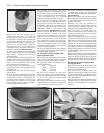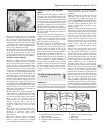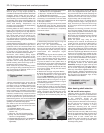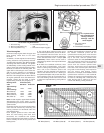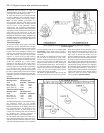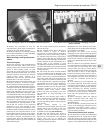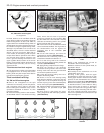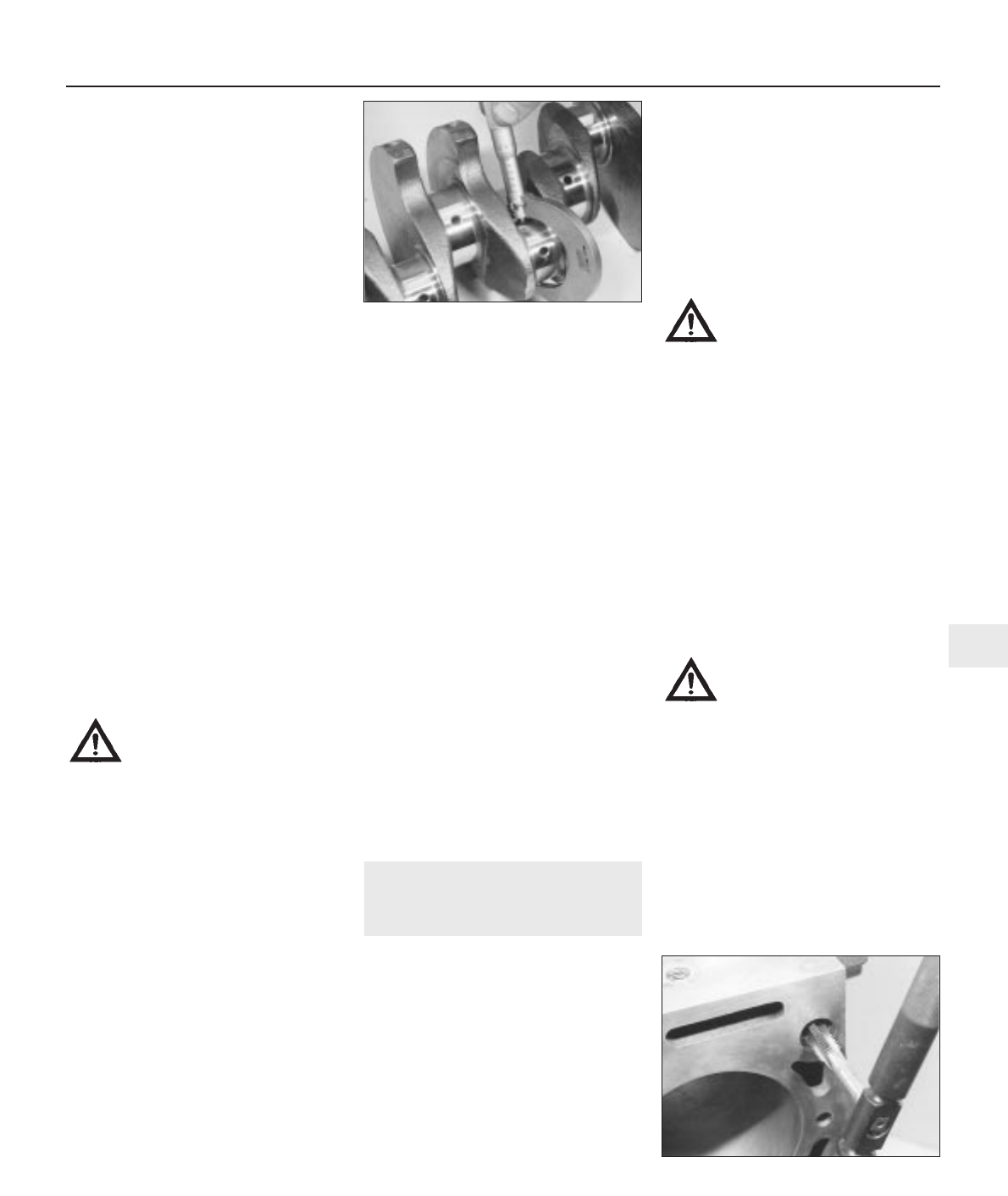
27 Before removing the crankshaft it is
advisable to check the endfloat as described
in paragraphs 6 and 7.
28 Unbolt and remove the crankshaft left-
and right-hand oil seal housings from each
end of the cylinder block, noting the correct
fitted locations of the locating dowels. If the
locating dowels are a loose fit, remove them
and store them with the housings for safe-
keeping.
29 Remove the oil pump drive chain, and
slide the drive sprocket off the end of the
crankshaft. Remove the Woodruff key, and
store it with the sprocket for safe-keeping.
30 The main bearing caps should be
numbered 1 to 5 from the transmission
(flywheel) end of the engine. If not, mark them
accordingly using a centre-punch or paint.
31 Unscrew and remove the main bearing
cap retaining bolts, and withdraw the caps.
Recover the lower main bearing shells, and
tape them to their respective caps for safe-
keeping.
32 Carefully lift out the crankshaft, taking
care not to displace the upper main bearing
shell.
33 Recover the upper bearing shells from the
cylinder block, and tape them to their
respective caps for safe-keeping. Remove the
thrustwasher halves from the side of No 2 main
bearing, and store them with the bearing cap.
Inspection
34 Clean the crankshaft using paraffin or a
suitable solvent, and dry it, preferably with
compressed air if available. Be sure to clean
the oil holes with a pipe cleaner or similar
probe, to ensure that they are not obstructed.
Warning: Wear eye protection
when using compressed air!
35 Check the main and big-end bearing
journals for uneven wear, scoring, pitting and
cracking.
36 Big-end bearing wear is accompanied by
distinct metallic knocking when the engine is
running (particularly noticeable when the
engine is pulling from low speed) and some
loss of oil pressure.
37 Main bearing wear is accompanied by
severe engine vibration and rumble - getting
progressively worse as engine speed
increases - and again by loss of oil pressure.
38 Check the bearing journal for roughness
by running a finger lightly over the bearing
surface. Any roughness (which will be
accompanied by obvious bearing wear)
indicates that the crankshaft requires
regrinding (where possible) or renewal.
39 If the crankshaft has been reground,
check for burrs around the crankshaft oil
holes (the holes are usually chamfered, so
burrs should not be a problem unless
regrinding has been carried out carelessly).
Remove any burrs with a fine file or scraper,
and thoroughly clean the oil holes as
described previously.
40 Using a micrometer, measure the
diameter of the main and big-end bearing
journals, and compare the results with the
Specifications (see illustration). By
measuring the diameter at a number of points
around each journal’s circumference, you will
be able to determine whether or not the
journal is out-of-round. Take the
measurement at each end of the journal, near
the webs, to determine if the journal is
tapered. Compare the results obtained with
those given in the Specifications.
41 Check the oil seal contact surfaces at
each end of the crankshaft for wear and
damage. If the seal has worn a deep groove in
the surface of the crankshaft, consult an
engine overhaul specialist; repair may be
possible, but otherwise a new crankshaft will
be required.
42 At the time of writing, it was not clear
whether Peugeot produce oversize bearing
shells for all of these engines. On some
engines, if the crankshaft journals have not
already been reground, it may be possible to
have the crankshaft reconditioned, and to fit
oversize shells (see Section 13). If no oversize
shells are available and the crankshaft has
worn beyond the specified limits, it will have
to be renewed. Consult your Peugeot dealer
or engine specialist for further information on
parts availability.
9 Cylinder block/crankcase -
cleaning and inspection
3
Cleaning
1 Remove all external components and
electrical switches/sensors from the block.
2 On aluminium block engines with wet
liners, remove the liners as described in para-
graph 11.
3 Scrape all traces of gasket from the cylinder
block/crankcase, and from the main bearing
ladder (where fitted), taking care not to
damage the gasket/sealing surfaces.
4 Remove all oil gallery plugs (where fitted).
The plugs are usually very tight - they may
have to be drilled out, and the holes re-
tapped. Use new plugs when the engine is
reassembled.
5 If any of the castings are extremely dirty, all
should be steam-cleaned.
6 After the castings are returned, clean all oil
holes and oil galleries one more time. Flush all
internal passages with warm water until the
water runs clear. Dry thoroughly, and apply a
light film of oil to all mating surfaces, to
prevent rusting. On cast-iron block engines,
also oil the cylinder bores. If you have access
to compressed air, use it to speed up the
drying process, and to blow out all the oil
holes and galleries.
Warning: Wear eye protection
when using compressed air!
7 If the castings are not very dirty, you can do
an adequate cleaning job with hot (as hot as
you can stand!), soapy water and a stiff brush.
Take plenty of time, and do a thorough job.
Regardless of the cleaning method used, be
sure to clean all oil holes and galleries very
thoroughly, and to dry all components well.
On cast-iron block engines, protect the
cylinder bores as described above, to prevent
rusting.
8 All threaded holes must be clean, to ensure
accurate torque readings during reassembly.
To clean the threads, run the correct-size tap
into each of the holes to remove rust,
corrosion, thread sealant or sludge, and to
restore damaged threads (see illustration). If
possible, use compressed air to clear the
holes of debris produced by this operation.
Warning: Wear eye protection
when cleaning out these holes
in this way!
9 Apply suitable sealant to the new oil gallery
plugs, and insert them into the holes in the
block. Tighten them securely.
10 If the engine is not going to be
reassembled right away, cover it with a large
plastic bag to keep it clean; protect all mating
surfaces and the cylinder bores as described
above, to prevent rusting.
Inspection (aluminium cylinder
block with wet liners)
11 Remove the liner clamps (where used),
then use a hard wood drift to tap out each
liner from the inside of the cylinder block.
Engine removal and overhaul procedures 2D•13
2D
8.40 Measuring a crankshaft big-end
journal diameter
9.8 Cleaning a cylinder block threaded
hole using a suitable tap



